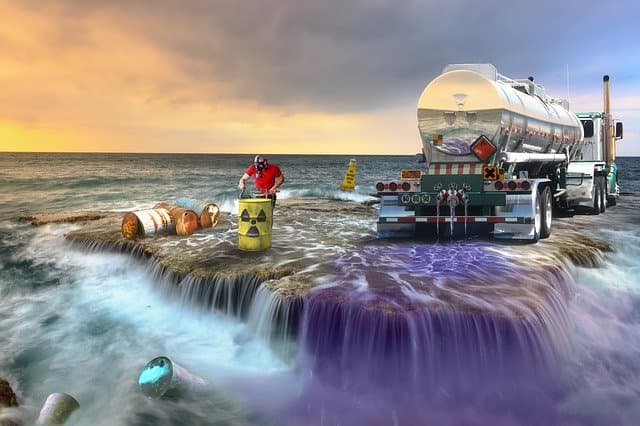Plastics are creating havoc on both land and water just because of one feature and that is they are non-biodegradable. Almost 150 metric tons of plastic are present in the oceans with a further 8 million tons that are added annually. Plastic once manufactured can only be recycled, can be converted into something else, or can be disposed into oceans or landfills. Plastics are also found along the coastline of Mariana Trench which is considered to be the deepest point in the ocean.
The main areas and oceans which are mostly affected by marine pollution are as follows.
- Dead Zone in the Gulf of Mexico in the Atlantic Ocean: The Gulf of Mexico is surrounded by the coast of Mexico, Cuba, and the USA. The dead zone present here is one of the largest in the world. The water is full of phosphorus and nitrogen that is disposed of from the farming states of Iowa, Missouri, Mississippi, and Wisconsin. The chemical turns the water hypoxic that is low in oxygen. Due to hypoxia, numerous different fishes also die here.
- North Atlantic Garbage Patch in the Atlantic Ocean:North Atlantic Garbage Patch extends for hundreds of kilometers and includes 200,000 pieces of garbage per square km. The main reason for this pollution is the usage of plastics which are never decomposed.
- Great Pacific Garbage Patch in the Pacific Ocean: Great Pacific Garbage Patch is situated near North Pacific Gyre and is mainly made of chemical sludge and plastics. The size of the patch is estimated to be 700,000 to 15 million sq km. Most debris from Asia and North America is getting collected in this patch. The marine debris from North America takes 6 years whereas trash from Asia takes around 1 year to reach the Great Pacific Garbage Patch.

- Indian Ocean: In 2010, a garbage patch was found in the Indian Ocean mainly due to plastics and chemical sludge. Right now the Indian Ocean contains 1.3 million plastics. It is the third biggest plastic collection in the world. This patch covers almost 10 million sq km. According to scientists, tropical cyclones that are increasing in the coastal regions of the Indian Ocean are mainly due to hypoxia present in the sea. Indus and Ganges are the two of the most polluted rivers in the world that both drains into this Ocean.
- Mediterranean Sea: The Mediterranean Sea is the number one polluted ocean on the earth. According to a report by the United Nations Environment Program, thousands of pollutants are dumped into the ocean. Among them, 129000 tons of mineral oil, 3800 tons of lead, 650000000 tons of sewage, 60000 tons of mercury, and 36000 tons of phosphates are the notable ones. According to Greenpeace, since the sea is mostly enclosed by lands, it will take more than 100 years to clean and renew the waters of the ocean. Due to the high rate of marine pollution, many marine animals are at risk of extinction. Among them, the Mediterranean Monk Seal is one of the most endangered animals in the world.
- Baltic Sea: The Baltic Sea is located between Eastern and Central Europe. Here oil spills, land pollution, and overfishing are the main causes of marine pollution. Half of the fish levels are below the critical biological level in the Baltic Sea. The Sweden Health Authorities have warned the people in the coastal regions to stop eating Baltic Herring from the sea.
- Caribbean Sea: The Caribbean Sea is situated on the northern side of the Atlantic Ocean. It is among those water bodies that are hugely destroyed due to human activities. Beads of Seagrass, mangroves, fisheries, Oysters, and coral are gradually disappearing from this Sea.
Thus we can conclude North Pacific Ocean has the most impact due to marine pollution with estimated polluted particles of 2 trillion. The fate of the marine world depends on the minimization of the plastics that are dumped into the ocean. But despite continuous efforts of the environmental and marine conventionalists, bulk amounts of plastics are still finding their way into the oceans.